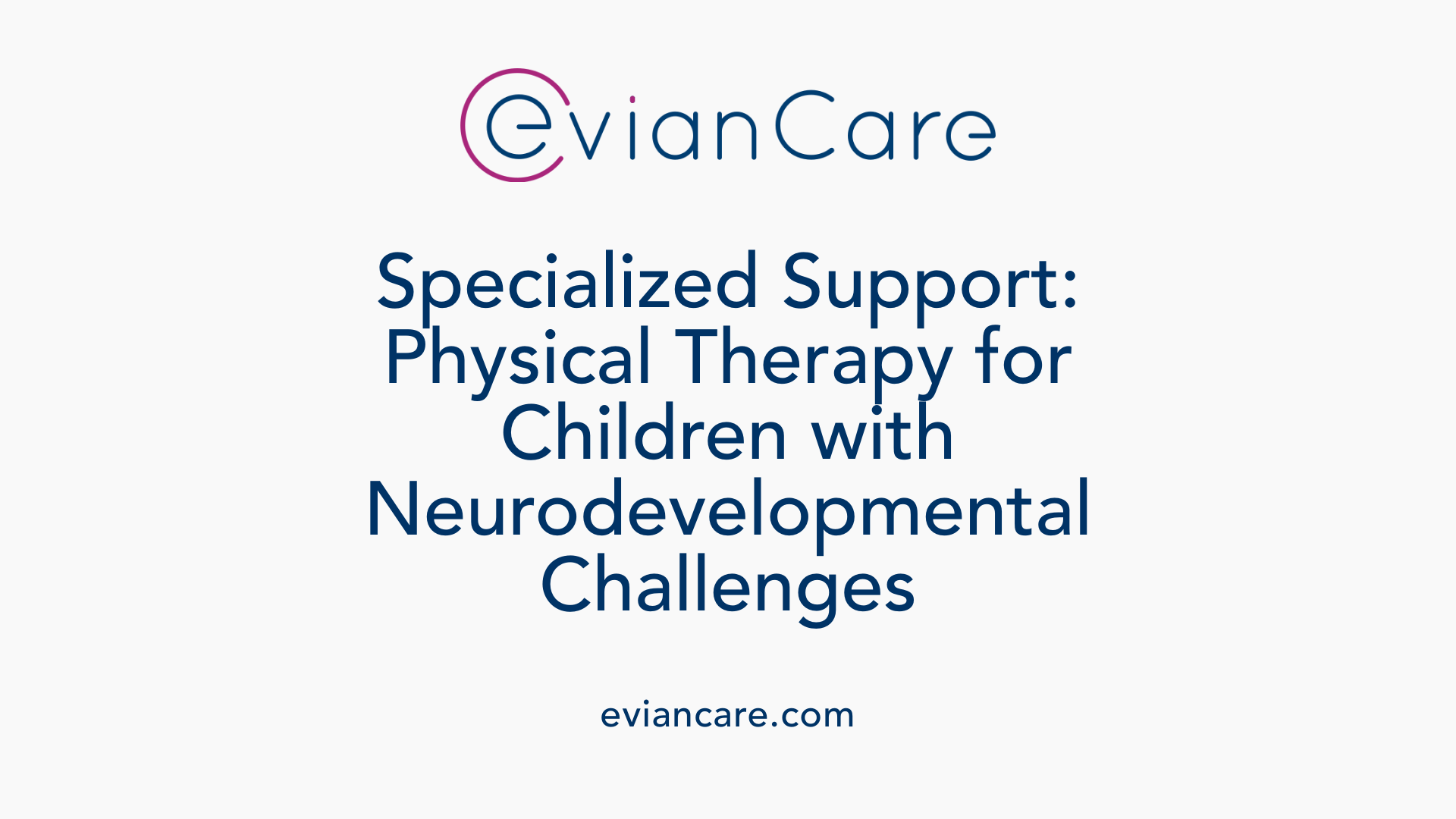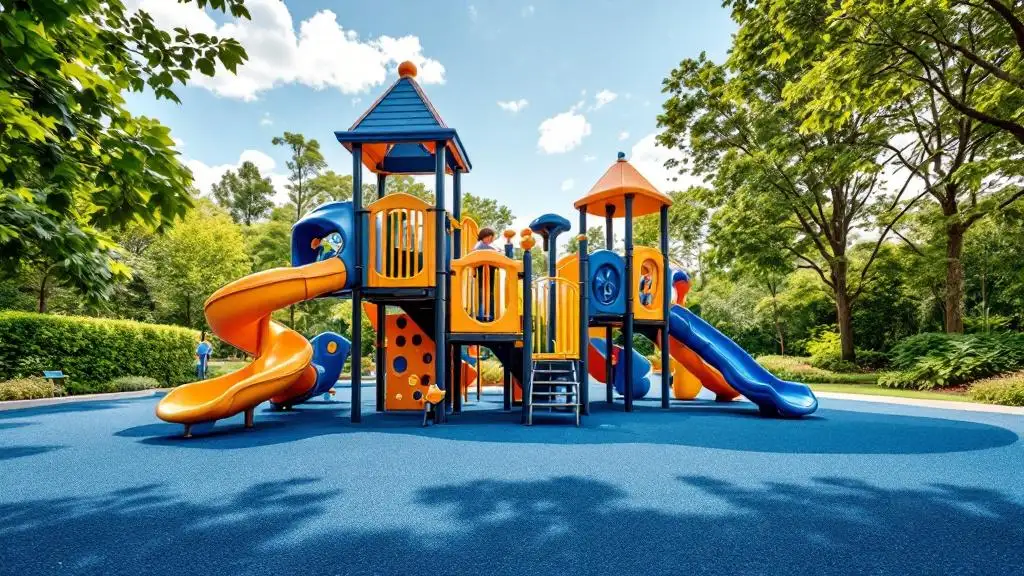
Understanding the Role of Physical Therapy in Child Development
Pediatric physical therapy plays a crucial role in supporting children's growth, helping them develop essential strength and endurance required for daily activities and overall development. By utilizing tailored exercises and play-based interventions, therapists aim to improve motor skills, balance, coordination, and functional mobility, ensuring children reach their developmental milestones and maintain an active, healthy lifestyle.
The Foundations of Muscular Strength and Endurance in Children

What is muscular strength and endurance in children?
Muscular strength is the capacity of muscles to exert force against resistance. Whether this resistance is static (isometric) or moving (isotonic), strength involves the ability to generate force. Muscular endurance, on the other hand, is the muscles' ability to sustain repeated or continuous force over time. In children, both these qualities are fundamental for engaging safely and effectively in everyday activities.
Developing muscular strength helps children perform tasks such as lifting, pushing, or climbing, while muscular endurance enables them to participate in longer periods of play or physical activities without fatigue. These physical attributes are vital for supporting a child’s growth, coordination, and overall health.
Why are strength and endurance vital for children's development?
Having good muscle strength and endurance is essential for a child's overall development. They support basic functions such as sitting upright, standing, walking, running, and playing. When these muscles are strong and durable, children are less prone to injuries, can maintain better posture, and have improved balance.
Beyond physical capabilities, developing these qualities also impacts metabolic health, bone density, and self-esteem. Children who build strength and endurance tend to progress through developmental milestones more smoothly, engage confidently in sports and recreational activities, and enjoy a greater sense of independence.
Activities like obstacle courses, swimming, and playground play are excellent ways to enhance these attributes. Regular participation in such activities not only improves physical health but also fosters social skills and emotional resilience. For children with specific needs, targeted therapy and supervised strength training programs are highly effective in boosting their physical abilities.
Overall, focusing on strength and endurance in childhood sets the foundation for lifelong fitness, health, and well-being. As children grow, maintaining and improving these qualities can significantly influence their ability to lead active, healthy lives.
How Pediatric Physical Therapy Builds Strength and Endurance

What techniques and exercises are commonly used in pediatric physical therapy to enhance strength and endurance?
In pediatric physical therapy, a variety of techniques and exercises are tailored to meet each child's unique needs, focusing on safely improving muscle strength and endurance. Therapists utilize functional movements like squats, lunges, and pushing or pulling activities that mimic daily tasks, helping children develop practical strength.
Resistive exercises with tools such as Therabands or light weights are common, enabling gradual resistance training that promotes muscular development without risking injury. Additionally, playful activities like animal walks (e.g., bear crawls, crab walks), obstacle courses, and yoga provide engaging ways to strengthen core and limb muscles.
Aquatic therapy is also beneficial, offering low-impact resistance that can enhance strength and cardiovascular endurance while being gentle on joints. All exercises are carefully adapted to the child's age and physical capabilities, ensuring safety, motivation, and ongoing progress.
How do play and functional activities support muscle development?
Play-based and functional activities play a vital role in building muscle strength and endurance in children. Games such as wheelbarrow races and tightrope walking challenge balance, coordination, and core stability while making movement fun.
Stuffed animal elevator rides and balance beam exercises help strengthen the trunk and leg muscles, critical for daily activities like walking and climbing. Incorporating obstacle courses and endurance games ensures that children develop stamina in an engaging, socially rewarding environment.
These activities not only improve physical strength but also foster motivation, confidence, and social skills. By mimicking real-world tasks through play, children can enhance motor planning and functional strength, which are essential for independence and proper development.
| Exercise Type | Purpose | Examples | Benefits |
|---|---|---|---|
| Resistance Activities | Build muscle strength | Theraband exercises, light weights | Promote muscle growth and endurance |
| Play-Based Activities | Engage and motivate children | Animal walks, obstacle courses, yoga | Improve coordination, balance, and core stability |
| Balance and Core Exercises | Enhance stability | Tightrope walks, balance beam | Support postural control and functional movements |
| Aquatic Therapy | Low-impact strengthening | Water resistance exercises | Reduce joint stress, improve cardiovascular health |
Physical therapy programs that include these techniques foster safe, enjoyable, and effective growth of strength and endurance. Regularly incorporating such activities supports children in reaching developmental milestones, participating fully in daily routines, and enjoying an active life.
Signs Indicating a Child May Benefit from Physical Therapy

What signs suggest a child might need physical therapy to improve strength and endurance?
Parents and caregivers should keep an eye out for certain developmental and physical cues that may suggest the need for professional assessment. Delayed achievement of motor milestones such as sitting, crawling, or walking can be early indicators. Poor muscle tone, which manifests as floppiness or stiffness, along with fatigue during routine activities like play or walking, are common signs of strength or endurance issues.
Difficulty maintaining balance, awkward movements, and problems with posture—such as slouching or leaning—may also point to underlying weaknesses or coordination problems. These signs can affect a child's ability to participate actively in daily routines and play activities.
Why is early intervention important for these signs?
Addressing these issues early through pediatric physical therapy is crucial. Early intervention takes advantage of neural plasticity, allowing the child to develop motor skills more effectively and prevent the formation of compensatory movement patterns that could lead to further complications.
Timely therapy can enhance muscle strength, improve coordination, and support the child's overall development. It also helps in minimizing long-term disabilities, boosting confidence, and ensuring children are able to participate fully in social and school activities.
Early detection and prompt treatment are essential to guiding children toward reaching their maximal developmental potential and maintaining a healthy, active lifestyle.
Evidence-Based Guidelines for Physical Therapy Interventions

Are there guidelines for using physical therapy to build strength and endurance in children?
Yes, multiple research-supported protocols recommend personalized, age-appropriate therapy methods. These include resistance exercises, functional movements, gait training, and aquatic activities tailored to each child's developmental stage and health condition.
Supervision by qualified therapists ensures exercises are performed correctly and safely, minimizing injury risk. Gradual increase in activity intensity, proper warm-up and cool-down routines, and technique-focused training are central components of a safe protocol.
Children’s programs often incorporate play-like activities, such as obstacle courses, animal walks, or balance exercises, which encourage engagement while promoting strength and endurance.
Regular assessments allow therapists to monitor progress, adjust exercises, and ensure optimal development of motor skills.
What are the key principles to ensure safe strength training for children?
Safety in pediatric strength training relies on several guiding principles:
- Qualified supervision: Only trained professionals should guide exercises to ensure proper technique.
- Progressive overload: Gradually increasing activity difficulty helps build strength without overburdening developing muscles and bones.
- Full joint range: Exercises should be performed through complete joint movements to ensure flexibility and adequate muscle engagement.
- Avoiding excessive loads: Loads should start low and increase slowly, respecting the child's physical limits to prevent injury, especially to growth plates.
- Inclusion of warm-up and cooldown: Proper preparation and recovery routines reduce injury likelihood and facilitate muscle adaptation.
- Regular evaluation: Continuous assessment of strength, flexibility, and technique enables safe progression and adjustments.
Incorporating these principles helps maximize benefits such as improved muscle strength, better bone density, enhanced balance, and overall physical health, while safeguarding the child's growth and development.
Supporting Children with Neurodevelopmental Differences

Why is physical therapy vital for children with neurodevelopmental challenges?
Physical therapy plays a crucial role in helping children with neurodevelopmental conditions improve their motor skills, strength, balance, and coordination. These improvements are essential for enabling children to participate more fully in daily activities, develop independence, and enhance their quality of life.
Early intervention is especially important. By beginning therapy at an early stage, therapists can prevent secondary complications such as muscle contractures, poor posture, and secondary injuries. It also supports neural plasticity, which refers to the brain's ability to adapt and rewire itself, fostering better developmental and social outcomes in the long term.
Early therapy sessions involve engaging, play-based activities that focus on building foundational motor skills, which are often delayed in children with conditions like cerebral palsy or other neurodevelopmental issues.
What activities are tailored for children with conditions like cerebral palsy?
Therapists utilize a variety of specialized techniques and activities to address the unique needs of each child. These include stretching exercises aimed at increasing flexibility, gait training to promote proper walking patterns, and strengthening exercises to improve muscle tone and endurance.
Adaptive methods such as neurodevelopmental treatment (NDT) focus on guiding movements in a way that promotes normal movement patterns and reduces abnormal reflexes. Aquatic therapy, which involves exercises in water, can additionally help reduce joint stress and improve mobility.
The activities are often customized to the child's specific condition, age, and developmental level to ensure they are engaging yet effective. Regular assessments help modify the therapy plan to maximize progress.
Pediatric physical therapy for these children not only boosts physical capabilities but also encourages confidence and emotional resilience as mobility improves. The combined approach of targeted exercises and early, consistent intervention provides the best foundation for supporting children's growth and independence.
Enhancing Endurance Through Specific Activities and Home Programs
Types of endurance activities
Building endurance in children can be achieved through various engaging activities that promote sustained physical effort. Aerobic exercises such as walking, swimming, dancing, and sports are particularly effective. These activities help improve cardiovascular fitness and muscular stamina. Incorporating obstacle courses, bike riding, or relay races offers fun ways to challenge endurance levels. Structure and variety in activities not only develop physical capacity but also keep children motivated.
Gradually increasing the duration and intensity of these exercises ensures steady progress without overwhelming young participants. Functional exercises like climbing stairs, jumping, or playing different sports incorporate endurance training into everyday routines. These tailored activities support children in reaching developmental milestones and participating confidently in physical routines.
Role of parents and caregivers
Parents and caregivers play a vital role in fostering endurance development at home. They can encourage children to engage in regular aerobic activities, starting with manageable durations and increasing as fitness improves. Making exercise fun and varied, such as combining dancing with games or outdoor activities, helps sustain interest.
Supporting healthy eating habits and establishing consistent routines around activity times reinforce the importance of physical fitness. For example, setting aside specific times for active play or family outings to parks or pools integrates endurance training seamlessly into daily life.
Parents can also observe signs that indicate a child's need for targeted endurance exercises, such as fatigue during play, difficulty completing tasks, or decreased participation in active routines. Addressing these signs early allows for timely intervention.
Supporting therapy at home involves guiding children through recommended exercises, creating structured activity schedules, and engaging in active play together. Providing positive reinforcement boosts motivation and confidence.
In summary, combining enjoyable activities with a supportive environment and routine consistency is essential. This approach helps children build stamina safely and effectively, leading to better physical health and greater independence in daily activities.
The Impact of Pediatric Physical Therapy on Child Development
How does physical therapy improve overall development and mobility?
Pediatric physical therapy plays a vital role in enhancing motor skills, strength, and balance in children. Through play-based activities, guided exercises, and specialized equipment, therapy helps children develop the physical abilities necessary for daily tasks. This improved mobility allows children to participate more actively and independently in routines such as walking, climbing, and playing.
By fostering these physical capabilities, therapy also supports cognitive, emotional, and social growth. Children gain confidence as they achieve movement milestones, which encourages further exploration and social interaction. As a result, children become more engaged in classroom activities, sports, and social play, contributing to their overall development.
What are the long-term benefits of early physical therapy intervention?
Starting physical therapy early in a child's life offers significant long-term advantages. Early intervention helps children achieve developmental milestones sooner and reduces the risk of secondary complications like poor posture or muscle weakness.
Children who receive therapy early often develop greater independence and confidence. They are more likely to participate fully in recreational and educational activities, which enhances their emotional well-being and social integration.
Furthermore, early physical therapy can lead to improved quality of life by reducing future disabilities, decreasing the need for extensive medical interventions later in life, and promoting better community participation. This early support sets a foundation for lifelong health, mobility, and participation.
Supporting Child Growth through Physical Therapy
Regular evaluations and tailored treatment plans are essential to maximize these benefits. Integrating exercises that improve strength, flexibility, and endurance helps children overcome barriers to movement and participation.
Parents and caregivers are also encouraged to incorporate recommended activities at home, fostering consistency and reinforcing progress made during therapy sessions. As children grow, ongoing support and reassessment ensure that therapy adapts to their evolving needs, further promoting lasting developmental success.
| Aspect | Benefits | Additional Details |
|---|---|---|
| Motor Skills | Improved coordination and movement | Includes walking, jumping, crawling |
| Strength & Balance | Greater physical stability | Reduces fall risk and supports daily activities |
| Independence | Enhanced ability to perform routines | Dressing, grooming, self-care |
| Social Skills | Increased confidence and participation | Engaging in group activities and sports |
| Emotional Development | Boosted self-esteem | Achieving milestones fosters positive emotions |
Through targeted, play-oriented therapy, children build essential physical skills that serve as the foundation for their overall growth and well-being.
Summary: The Path to Healthy Growth and Physical Resilience in Children
How can children develop strength and endurance effectively?
Developing muscular strength and endurance is vital for children's overall health and ability to perform daily activities confidently. Strength refers to the capacity to exert force against resistance, whether holding a position (isometric) or moving through a range of motion (isotonic). Endurance enables muscles to exert force repeatedly over time, supporting activities like play, climbing, and sports.
Engaging children in activities such as obstacle courses, swimming, animal walks, and playground play can significantly enhance these physical qualities. These activities promote muscle building, balance, coordination, and cardiovascular stamina in an enjoyable way. For example, animal walks target limb and core strength, while tightrope walks challenge balance and postural control. Using simple tools like stickers on feet or paper plates for ice skating adds fun and functional challenge to core strengthening and balance activities.
How does a holistic approach benefit children's physical development?
A comprehensive approach to developing strength and endurance combines various techniques tailored to each child's needs. Pediatric physical therapy plays a central role, with therapists assessing motor skills, flexibility, and strength to design personalized exercise programs. These may include resistance training, balance activities, and play-based exercises that are engaging and suitable for each age.
Therapies such as adapted yoga, wheelchair activities, or aquatic exercises like water walking can support children with specific needs, including neuromuscular conditions like cerebral palsy or developmental delays. Additionally, activities like scooter board races, Simon Says, or stuffed animal elevator rides make strengthening routines interactive and motivational.
Integration of techniques for safe, effective progress
Effective strength and endurance development requires integrating various techniques such as resistance training, aerobic conditioning, and functional exercises. Strengthening core muscles improves overall stability and posture, reducing injury risks. Aerobic activities like obstacle courses or cycling enhance cardiovascular endurance.
Proper supervision, gradual progression in intensity and duration, and ensuring exercises are safe and appropriate help prevent injuries like epiphyseal plate fractures or lower back strain. Regular assessments and caregiver involvement ensure the programs adapt to a child's evolving abilities, maximizing benefits.
By incorporating these diverse strategies into daily routines, children can build physical resilience, improve motor skills, and gain confidence. A commitment to holistic, multidisciplinary intervention fosters healthy growth, supports developmental milestones, and promotes lifelong physical activity habits.
Empowering Children for a Stronger Future
Pediatric physical therapy is a vital component in fostering children's strength, endurance, and overall physical development. Through individualized, engaging, and evidence-based interventions, children can achieve their developmental milestones, improve their mobility and confidence, and enjoy an active, independent life. Early assessment, consistent therapy, and supportive home environments are key to unlocking each child's full potential, promoting lifelong health and resilience.
References
- Strength and Endurance - Kid Sense Child Development
- 10 Pediatric Physical Therapy Exercises & Activities | RVPT
- Top 5 Benefits of Pediatric Physical Therapy
- Strength Training in Children and Adolescents: Raising the Bar for ...
- 10 Amazing Benefits of Physical Therapy for Kids
- Physical Therapy for Kids - Pediatric Physical Therapy
- Enhancing Child Development With Pediatric Physical Therapy
- Resistance Training for Children and Adolescents | Pediatrics












